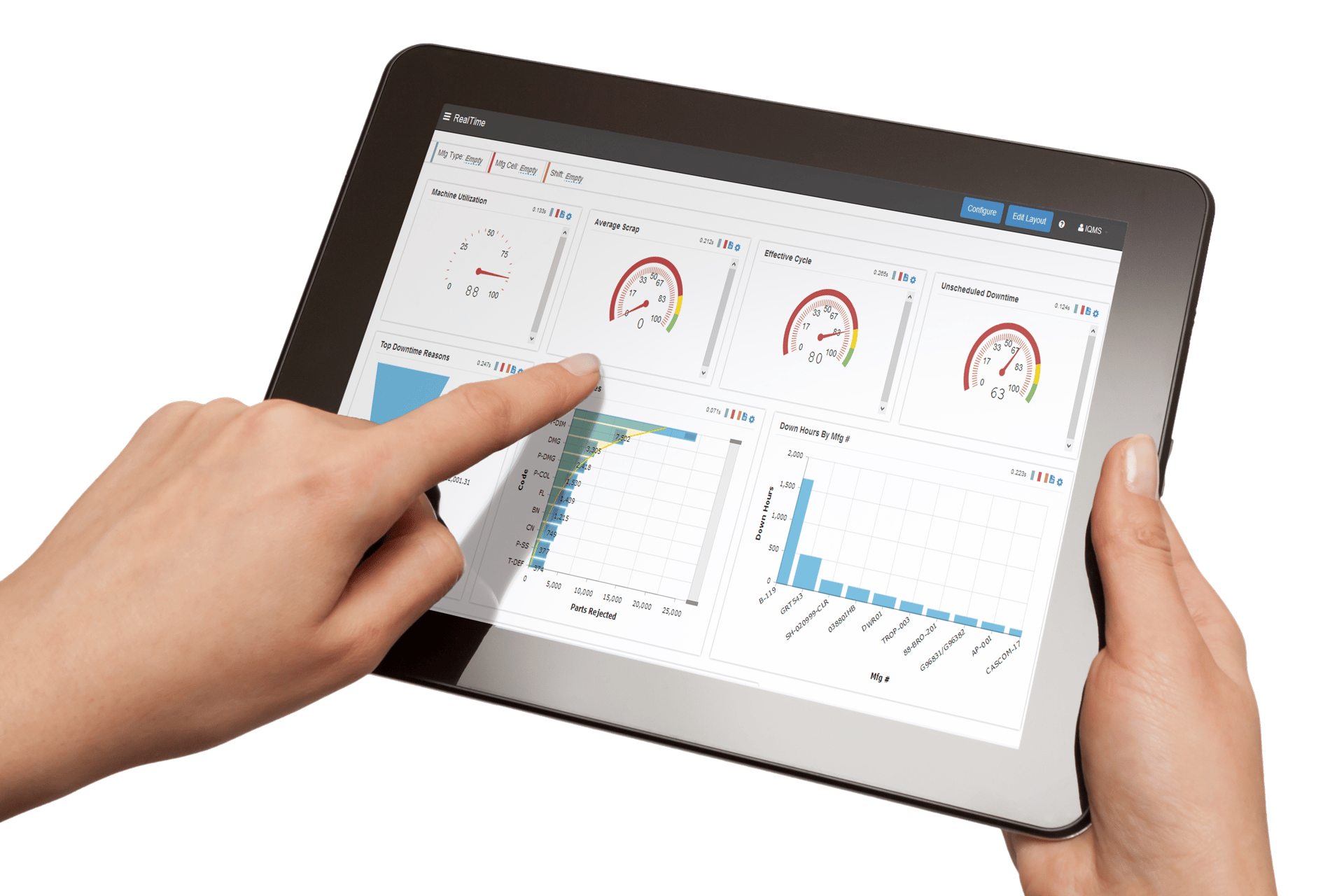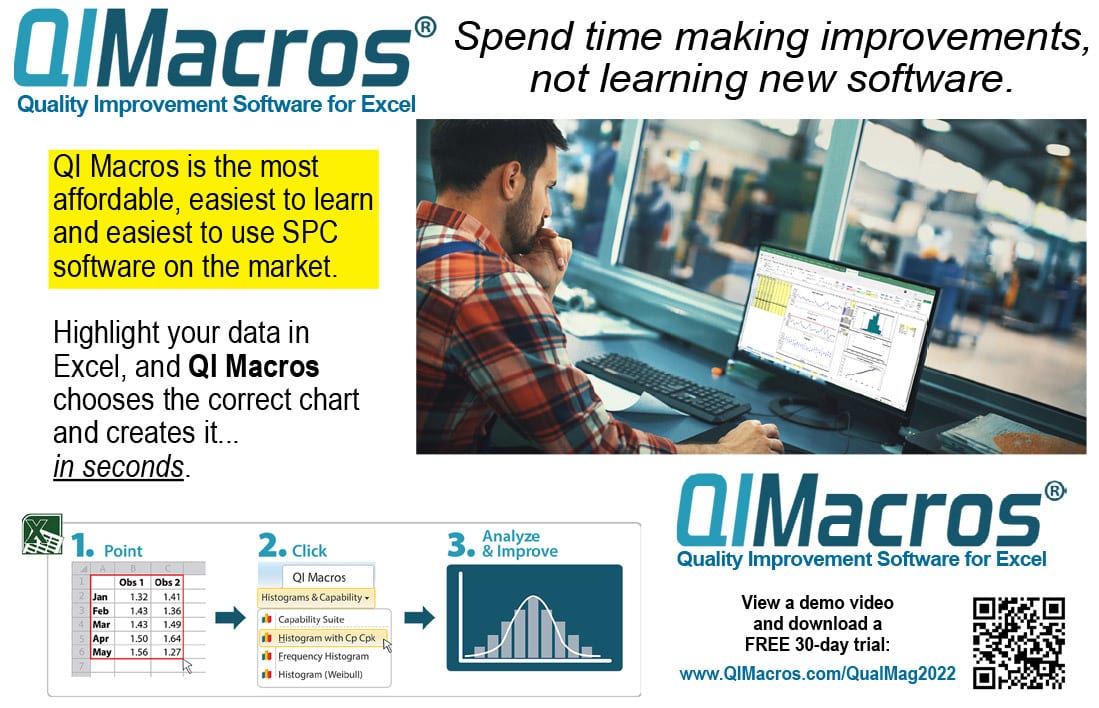Manufacturers’ Top Demands for
Quality Software in 2022
Software & Analysis
The bottom line is that manufacturers know they need to improve how integrated quality data is across the company. By Louis Columbus
Competing on product quality has never been more urgent as rising raw material and component costs continue to squeeze manufacturers’ margins. At the same time, unpredictable supply chains make it increasingly difficult to maintain consistent product quality and cost visibility. In the midst of these challenges, manufacturers are strengthening their evolving in-house and virtual workforces to play more integral roles in meeting the company’s quality goals. This in turn is bringing new demands on software to help manufacturers navigate cost and supply chain uncertainty to deliver the highest product quality.
For example, there is less room for scrap or defective products when raw material costs climb. Having a real-time view of yield, scrap, and defect rates plus an understanding why they are happening is one of the many areas where quality software adds value today. Another example is using software to identify new opportunities for reducing costs and working with key suppliers to improve yields. Additionally, quality software can help improve yields and reduce waste by providing accurate work instructions across every shop floor, work center, and team. When everyone owns product quality, having intuitive, easy access to quality data becomes critical to getting the job done.
Integrating Real-Time Quality Data Is the Future of Manufacturing
The bottom line is that manufacturers know they need to improve how integrated quality data is across the company. At the heart of this strategy is capturing real-time product and process data from a variety of programmable logic controllers (PLC) and sensors, including advanced Industrial Internet of Things (IIoT) sensors and devices, which can provide insights into where and how product quality can be improved. Moreover, because everyone owns quality, there is a priority on integrating quality-related data into every digital workflow.
While product quality has always been a core value in manufacturing, it’s being relied on more than ever to reduce risks and keep costs under control. For instance, in the wake of rising costs for raw materials, components and assemblies, manufacturers are turning to more closed-loop systems and real-time data than ever before. At the same time, companies are relying on real-time data to increase the accuracy of in-line inspections; improve routing flexibility, scheduling accuracy, and load balancing; and streamline final assembly. Collectively, this is driving demand for applications with configurable options for capturing real-time quality data.
Notably, as manufacturers prioritize product quality across every area of production operations, they increasingly need real-time data access on any device, anywhere on the shop floor, or working offsite. This has accelerated the adoption of mobile and cloud-based quality software to deliver real-time insights into key quality metrics.




Fifteen Top Quality Software Features for Modern Manufacturing
Most manufacturers agree with the general approaches to leveraging quality software, but the practical applications of these strategies can vary significantly from one company to the next. After reviewing the best practices of several manufacturing companies, fifteen quality software features have emerged as the most important ones for more effectively managing costs, reducing waste, and improving product quality. Together, they provide a useful roadmap.
- Improved Data Migration. Getting data migration right from multiple legacy and third-party systems continues to be a roadblock to attaining higher levels of product quality. Manufacturers are turning to up-to-date tools for importing data, with a focus on master data management. Some companies are also moving to have their quality, manufacturing, and enterprise resource planning (ERP) systems run on the same database.
- Cloud-based Document Control and Management. As manufacturers seek to make work instructions and engineering change notices (ECNs) accessible in real time, many view having an automated, secure document control and management system in the cloud as a must-have. The most effective cloud-based systems provide deeper support for electronic storage, version control, and retrieval of quality documents.
- Improved Complaint Management. Tracking customer complaints and tying them back to return material authorizations (RMAs) is one of the most common requests manufacturers have for this feature. They also want advanced analytics to quickly identify trends in complaints RMAs and isolate product failure trends in the field. The most effective complaint management systems can also provide product management and development with new product ideas using predictive analytics.
- Enterprise systems integration with APIs. Manufacturers want to get beyond adapters and connectors, which are typically updated with every new code release. Adapters also prove brittle over time, breaking if there’s a slight change in the software they are connecting. Instead, manufacturers increasingly rely on API-driven integration that ensures compatibility between their quality management software and other applications.
- Expanded Failure Modes and Effects Analysis (FMEA). Manufacturers are looking to reduce the risk of new product failures given the tight supply chains for new materials. They rely more on FMEA to get product quality right at the prototype level first. FMEA has increased importance since the risks associated with every new product development cycle are higher and more expensive but also more lucrative if a new product succeeds.
- Improved Corrective & Preventive Action (CAPA) and Incident Management. CAPA can’t be an island anymore. The data it provides is essential for enabling everyone in the organization to own product quality. Manufacturers want to get CAPA data better distributed through their operations so all departments can see what’s causing nonconforming or unplanned events. Their goals are to fast-track investigations, improve action plan development and implementation of preventive actions, and reduce the risk of recurrence.
- Internal Control Systems Analytics. Manufacturers seek to improve their ability to keep their manufacturing operations in compliance with applicable laws and regulations. Internal control systems analytics help these companies confirm that policies and procedures are implemented effectively to ensure compliance, improve operational efficiency, and improve visibility and control.
- More Real-Time Change Control. Manufacturers need real-time data that supports their workflows and processes to achieve more real-time change control. Through these insights, they can see how changes in quality processes, procedures, and corrective actions contribute to higher product quality.
- Real-Time Data Submission and Reporting. Manufacturers need to capture product quality data from legacy and third-party systems into a single, unified view of quality company-wide. Manufacturing firms are increasingly demanding that quality systems go beyond raw data dumps to provide more intuitive, graphical dashboards for reporting data in context so they can take action.
- Real-time Production and Process Monitoring. As noted earlier, manufacturers need real-time visibility into machine and process management to keep production schedules updated, ensure orders are on track, and identify potential roadblocks.
- In-Line Product Quality and Consistency Tools. Manufacturers rely on these tools to achieve in-line product quality and reduce the variation in finished products by identifying problem areas in production early.
- Real-Time Risk Assessments. As they navigate market uncertainty, manufacturers are putting a higher priority on using advanced quality software functionality to quantify risk assessments in real time via financial modeling and identify their potential causes.
- Standards-Based Sensor Integration. Manufacturers don’t want to be locked into a limited property sensor network. More and more, they are turning to quality software solutions that support open standards across all sensors, giving them the flexibility to support future requirements.
- More comprehensive Supplier Quality Management. Manufacturers are looking for quality software solutions with improved tools for measuring and managing the quality of both indirect and direct material suppliers. They are also looking for more support to track and manage quality levels at manufacturing service providers.
- Virtual Support for Training and Qualification. As quality becomes a company-wide collaboration, manufacturers are looking beyond product quality solutions to software that can more effectively manage responsibilities, training, and certification requirements for employees. Similarly, there is more demand for training and certification systems for suppliers, partners, and service providers to make sure certification goals are being achieved as well.
Conclusion
Quality software’s usefulness was proven over the last few years in how well it helped manufacturers cope with uncertainty, exceptional risk, and unanticipated growth opportunities. Cloud-based solutions and mobile clients that provide anytime, anywhere access, a greater variety of real-time analytics, and standards-based integration with IoT and IIoT devices are now table stakes. Add to that the critical role of real-time data in empowering manufacturers to meet their quality goals and grow, and the future of quality software becomes clear.

